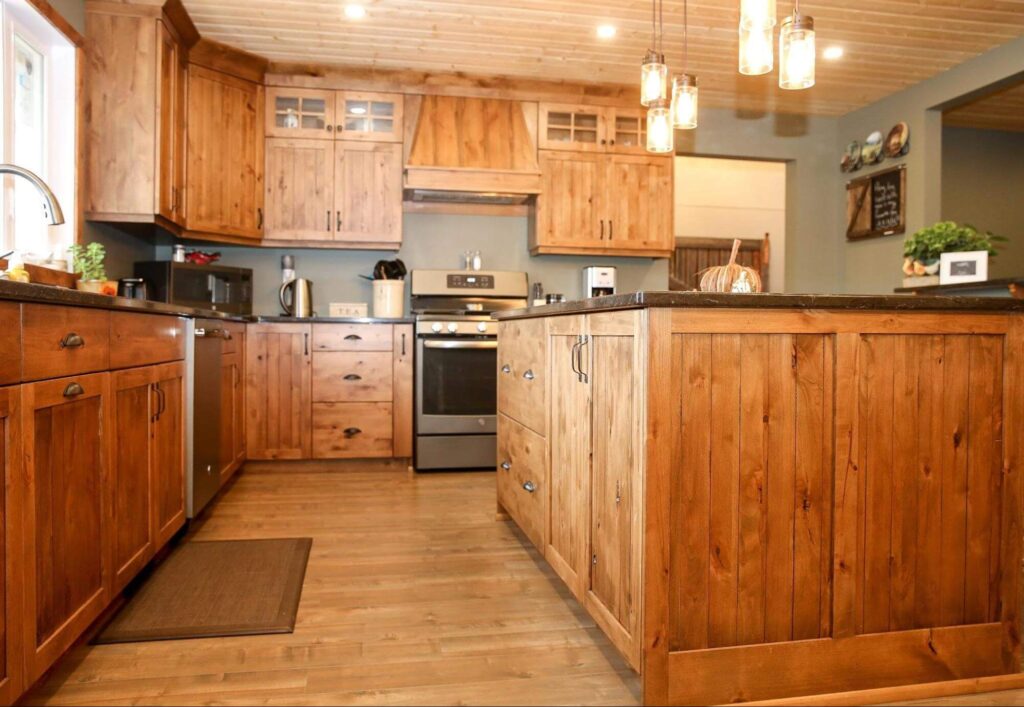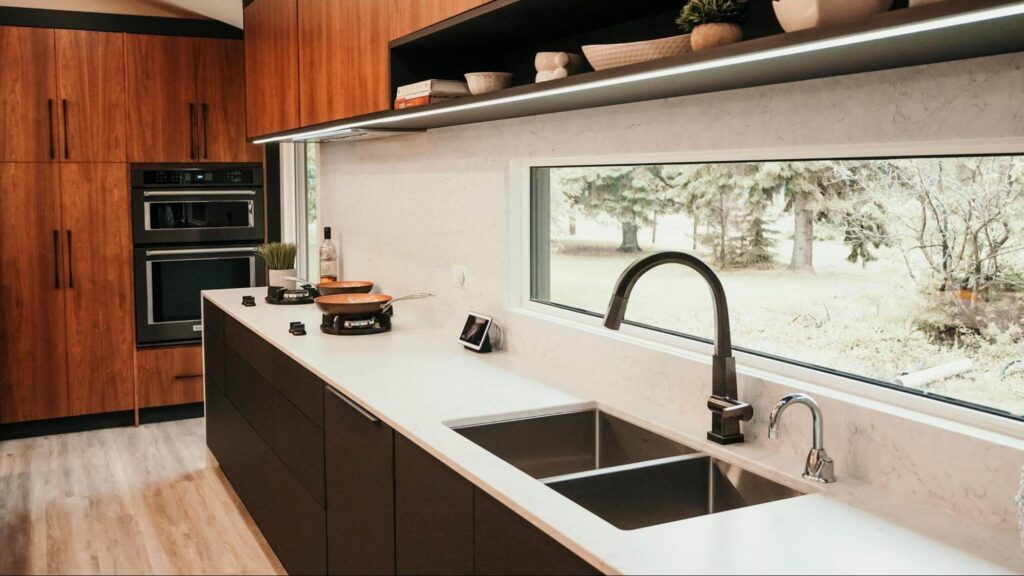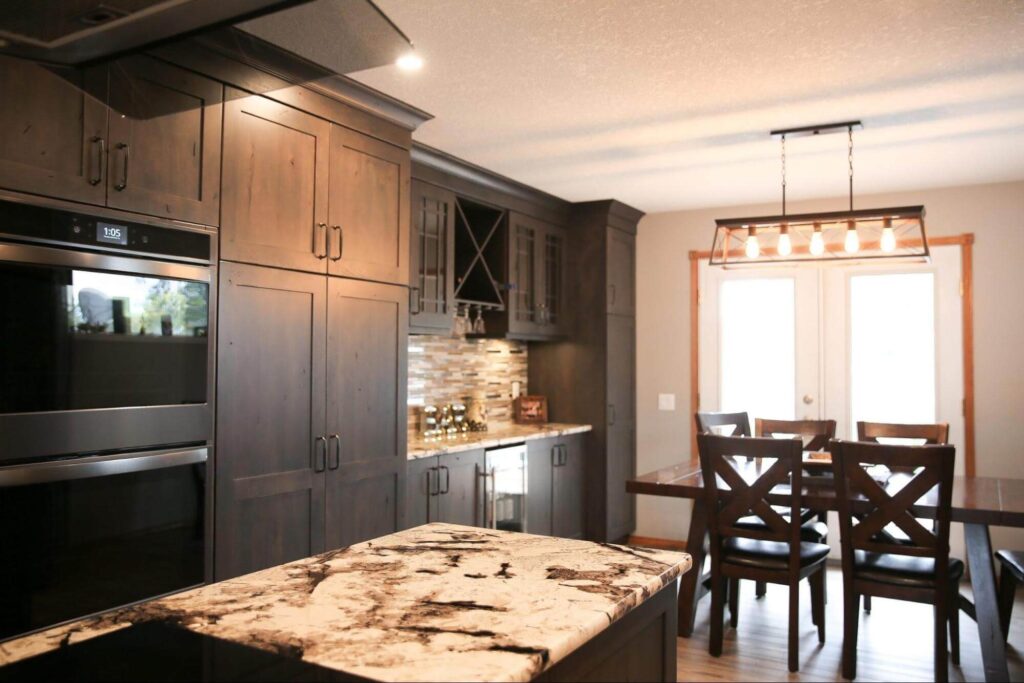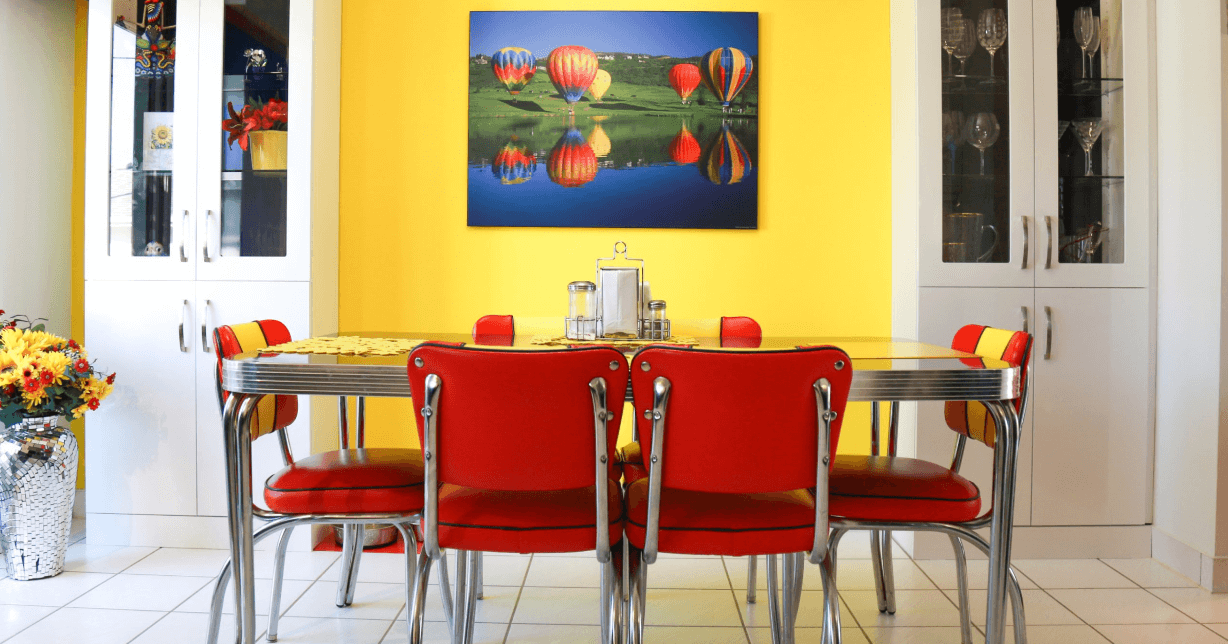The kitchen, often known as the heart of the home, serves as more than just a place for culinary adventures. It acts as a reflection of one’s personal style and aesthetic preferences. With many design styles available, homeowners often need help finding between two popular kitchen designs: Modern and Contemporary. While these terms are commonly used interchangeably, a closer examination reveals subtle nuances and distinct characteristics that set them apart. This guide aims to shed light on these differences, providing clarity for those embarking on a kitchen transformation that resonates with their unique style.
Understanding Modern vs. Contemporary
In design and architecture, terms often evolve, overlap, or become interchangeable and confusing. Two words in kitchen design that frequently get mixed up are “Modern” and “Contemporary.” Let’s demystify these concepts:
Modern Design
- Origins: Rooted in the early to mid-20th century Modernism movement.
- Characteristics: Emphasizes form and function, exhibiting clean lines, minimalistic features, and unadorned spaces. It focuses on neutral colours and commonly uses wood, leather, teak, and linen.
- Time-Frame: Despite being called “Modern,” this design style represents a specific historical period and remains unchanged.
Contemporary Design
- Origins: Represents the current design trends.
- Characteristics: More fluid and can be a blend of various styles that are currently in vogue. It may incorporate elements from Modernism, Post-Modernism, and other global styles. As trends change, so do the components of Contemporary design.
- Time-Frame: It’s ever-evolving and reflects the popular styles of the present day.
“Modern” design is rooted in a specific historical period, whereas “Contemporary” design continually adapts to the present. Grasping these distinctions aids in making informed design choices.
The Evolution of Kitchen Design
During the early 20th century, kitchens served a purely utilitarian purpose and were often secluded from the rest of the house. However, as the Modernism movement gained momentum and open floor plans gained popularity, the kitchen design concept underwent a remarkable transformation. Architects and designers started incorporating clean lines and minimalist elements, giving kitchens a fresh aesthetic.
The shift to Modern aesthetics in kitchen design laid the groundwork for the emergence of Contemporary design in the latter half of the 20th century. Designers began applying cutting-edge technology and innovative materials to create even more elegant and sophisticated kitchens. Contemporary design amplified the idea of open layouts, further blurring the boundaries that traditionally separated living spaces. As a result, Contemporary design represents an ever-evolving trend that adapts fluidly to current aesthetic preferences and functional requirements.
Kitchen design has undergone significant transformations, shaped by societal changes, technological advancements, and evolving aesthetic tastes.
Traditional Kitchen Design: Evoking a sense of warmth and charm, traditional kitchens were marked by their timeless appeal. Characterized by wood cabinetry with intricate carvings, classic colour palettes predominantly featuring whites, creams, and browns, and appliances such as stoves with decorative hood ranges, these kitchens emphasized detail and ornamentation.

Modern Kitchen Design: With the 20th century’s onset, the Modernism movement shifted towards functionality and minimalism, aligning with the rise of open floor plans. This era favoured clean lines, minimalist elements, and sleek materials like stainless steel or laminate. Kitchens transitioned to become more integrated with other living spaces, and design elements became streamlined, reflecting efficiency and elegance.

Contemporary Kitchen Design: Building on the groundwork laid by modern design, contemporary kitchens emerged in the latter half of the 20th century as a blend of the previous styles while also integrating current trends. Their adaptability characterizes them, often incorporating cutting-edge technology and innovative materials. Contemporary design is ever-evolving, and while it may draw inspiration from modernism, it also integrates various styles that are in vogue, resulting in stylish and functional kitchens.

As we trace this journey, from the ornate details of traditional designs to the sleek efficiency of modern aesthetics, and now to the dynamic and adaptable features of contemporary styles, it’s evident that kitchens have not just been spaces of culinary endeavour but also a reflection of the changing times and tastes.
Core Elements of Modern Kitchen Design
Minimalist Aesthetics and Functionality: Modern kitchens emphasize minimalism, clean lines, and space efficiency.
- Clean Lines: Modern kitchens prioritize straight edges, sharp angles, and squared-off shapes in cabinets, countertops, and appliances.
- Sleek Surfaces: Common materials are stainless steel, glass, and quartz for countertops and backsplashes.
- Open Shelving: Modern designs often favour open shelving over traditional closed cabinets for aesthetics and display.
- Efficient Storage: Innovative solutions like pull-out pantries, corner drawers, and vertical dividers are integrated to maximize space.
- Streamlined Appliances: Built-in appliances are a hallmark, enhancing the kitchen’s aesthetic while conserving counter space.
- Organizational Features: Spaces for recycling bins and integrated charging stations are modern kitchen conveniences that elevate functionality.
By incorporating these elements, modern kitchens seamlessly blend style and practicality.
Integration of Technology: Modern kitchens also leverage technology for efficiency and convenience, with features like advanced appliances with touch-screen controls and LED lighting solutions enhancing the culinary experience.
Core Elements of Contemporary Kitchen Design
Contemporary kitchens build on modern aesthetics but evolve to mirror current trends:
- Sleek Materials: Stainless steel, glass, and polished wood dominate contemporary kitchens, offering a stylish yet functional appeal.
- Colour Palette: Neutral shades like white or gray are the base, with occasional pops of vibrant colours adding visual interest.
- Open Concept Layout: Favored in contemporary designs, available layouts foster a seamless transition between the kitchen and adjacent living spaces, enhancing the social and functional dynamics of the area.
With these core elements, contemporary kitchens capture a balance between evolving style trends and functional needs, providing homeowners with spaces that are both inviting and efficient.
Similarities Between Modern and Contemporary Designs
Clean Lines
Both modern and contemporary kitchens prioritize sleek and minimalist designs. These designs prioritize functionality over ornate details, creating a streamlined look that is both visually pleasing and highly practical.
Neutral Color Palettes
Modern and contemporary kitchens often feature neutral colour palettes. Shades of white, gray, beige, or black are commonly used to create an understated elegance. This allows for versatility in design choices and ensures a timeless appeal that won’t quickly go out of style.
Emphasis on Functionality
Another shared characteristic between modern and contemporary kitchen designs is the emphasis on functionality. Both styles prioritize efficiency by incorporating innovative storage solutions and ergonomic layouts that make cooking tasks easier. The focus is on creating a visually appealing space that functions efficiently for daily use.
Adopting these similarities from modernism and contemporaneity into your kitchen design process, you can achieve a balanced blend of timeless aesthetics with practical functionality for a truly remarkable culinary experience.
Key Differences to Keep in Mind:
Design Aesthetics
- Modern kitchen design often incorporates sleek lines and minimalist elements, while contemporary kitchen design embraces a more eclectic and flexible approach.
- Modern kitchens tend to feature clean and simple designs focusing on functionality, whereas contemporary kitchens can incorporate various styles and materials for a more unique look.
- In modern kitchen design, neutral colours are prominent, while contemporary kitchens may include bolder colour choices or mix different textures in their overall aesthetic.
Materials and Finishes
Modern kitchens often feature sleek and industrial materials like stainless steel, glass, and concrete. In contrast, contemporary designs incorporate natural elements like wood or stone, creating a warmer ambiance.
Both modern and contemporary kitchens can showcase high-quality finishes like lacquer or matte surfaces. However, modern kitchens often favour smooth textures for an ultra-modern effect, while contemporary kitchens may embrace textured finishes to add depth and visual interest.
Cabinetry Styles
Modern kitchen cabinets are known for their sleek and minimalistic design, featuring flat panels without elaborate mouldings or embellishments. The handles often need to be more streamlined or present, adding to the clean and contemporary look.
On the other hand, contemporary kitchen cabinets offer more versatility in style. While they can still embrace minimalistic designs similar to modern cabinets, they also provide the option to incorporate shaker-style doors with decorative elements if desired. This allows for a balance between simplicity and added character in your kitchen design.
Understanding these key differences will guide you in deciding whether you want your kitchen space to exude a cutting-edge and modern feel or a trendy yet adaptable contemporary vibe. Consider these factors when planning your kitchen design project to create a space that aligns with your vision and style preferences.
The Influence of Minimalism in Contemporary Kitchen Design
Minimalism significantly influences contemporary kitchen design, emphasizing clean lines and clutter-free spaces. This design approach prioritizes simplicity and functionality, ensuring each element serves a purpose. In minimalist kitchens, decorative elements and excessive ornamentation are intentionally minimized.
A key characteristic of minimalist kitchen design is neutral colours such as white, gray, or beige. These hues create a serene ambiance while enhancing spaciousness in smaller kitchen areas. Another distinctive feature is the incorporation of sleek materials like stainless steel or glass for countertops and cabinetry, resulting in a polished and sophisticated appearance.
Benefits of Minimalist Kitchen Design:
- Streamlined functionality: By eliminating unnecessary decorations and items from the kitchen space, minimalism enhances organization and ease of use.
- Enhanced aesthetics: The focus on clean lines and simple design creates an elegant look that withstands the test of time.
- Simplified maintenance: With fewer trinkets and unnecessary features to clean or maintain, minimalistic kitchens are more efficient when cleaning chores.
- Heightened sense of tranquillity: A clutter-free environment reduces stress levels while providing ample space for culinary creativity.
Tips for Choosing Between Modern and Contemporary
Key factors to consider
Several key factors must be considered when deciding between modern and contemporary kitchen designs. Firstly, it’s crucial to consider your personal style preference. Look at pictures of both styles online or in magazines to understand which one resonates with you the most.
Another critical aspect to consider is the overall aesthetic of your home. A modern kitchen might appear out of place if you have a traditional or vintage-style home. Conversely, if your home features clean lines and contemporary elements throughout, a modern kitchen can beautifully complement the existing design.
By carefully considering your personal style and the overall aesthetic of your home, you can make an informed decision that ensures your kitchen design aligns harmoniously with your preferences and the existing ambiance of your living space.
Practicality Matters
When choosing between modern and contemporary kitchens, it’s essential to consider more than just style and aesthetics. Practicality plays a crucial role in this decision-making process.
Modern kitchens prioritize functionality by incorporating efficient storage solutions into sleek cabinetry. On the other hand, contemporary kitchens embrace open-concept designs, promoting seamless flow between cooking, dining, and entertaining areas.
To make the right choice, reflect on your daily kitchen usage and specific needs. Whether you require ample counter space or an island for meal preparation, these considerations will guide you toward a design that aligns with your style preferences and fulfills your practical requirements.
Blending Modern and Contemporary Elements in Kitchen Design
In kitchen design, incorporating modern and contemporary elements can create a stylish and functional space that perfectly suits your taste. Here are some valuable tips to help you achieve this aesthetic:
- Harmonize sleek lines with warm textures: Integrate modern fixtures and appliances such as stainless steel or matte black finishes. Complement these with contemporary touches like natural wood or textured materials.
- Embrace minimalistic yet impactful details: Opt for minimalist cabinetry handles, faucets, and lighting fixtures that make a statement without overpowering the overall design. Embracing simplicity will create a visually pleasing and uncluttered look.
- Mix materials for visual interest: Combine different materials like glass, metal, stone, and wood to add depth and texture to your kitchen. Consider using contrasting colours or patterns to enhance the visual interest and create a dynamic atmosphere.
Blending modern and contemporary elements offers a harmonious mix of sleek functionality and vibrant aesthetics. This combination will improve the functionality of your kitchen while providing a visually appealing space that merges timeless elegance with current trends.
Conclusion
Exploring the nuances of kitchen design, particularly the distinctions between modern and contemporary aesthetics, can be an exciting yet challenging endeavour. This journey through history, style, and functionality empowers homeowners to create spaces that deeply resonate with their tastes. While the terminologies may occasionally overlap or appear interchangeable, discerning their differences and similarities enables individuals to make informed design decisions. Whether embracing the timeless allure of a modern design, the evolving charm of contemporary style, or a harmonious blend of both, the ultimate objective remains constant: crafting a culinary sanctuary that is both functional and visually captivating. As you embark on your kitchen transformation journey, let these insights illuminate your path, leading you to a space that truly reflects your unique style and aspirations.
Ready to transform your kitchen space? MOD is here to help. Whether it’s complete kitchen renovations, building custom kitchens, or blending modern and contemporary designs, our experts have you covered.
Start your kitchen transformation journey today! Contact us online or call us at 780-997-0909.

